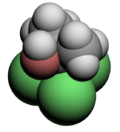- Chlorobutanol
-
Chlorobutanol 
 1,1,1-Trichloro-2-methylpropan-2-olOther names1,1,1-trichloro-2-methyl-2-propanol, chlorbutol, chloreton, chloretone, chlortran, trichloro-tert-butyl alcohol, 1,1,1-trichloro-tert-butyl alcohol, 2-(trichloromethyl)propan-2-ol, 1,1,1-trichloro-2-methyl-2-propanol, tert-Trichlorobutyl alcohol, trichloro-tert-butanol, trichlorisobutylalcohol, 2,2,2-trichloro-1,1-dimethylethanol
1,1,1-Trichloro-2-methylpropan-2-olOther names1,1,1-trichloro-2-methyl-2-propanol, chlorbutol, chloreton, chloretone, chlortran, trichloro-tert-butyl alcohol, 1,1,1-trichloro-tert-butyl alcohol, 2-(trichloromethyl)propan-2-ol, 1,1,1-trichloro-2-methyl-2-propanol, tert-Trichlorobutyl alcohol, trichloro-tert-butanol, trichlorisobutylalcohol, 2,2,2-trichloro-1,1-dimethylethanolIdentifiers CAS number 57-15-8 
ChemSpider 13842993 
UNII HM4YQM8WRC 
KEGG D01942 
Jmol-3D images Image 1 - ClC(Cl)(Cl)C(C)(C)O
Properties Molecular formula C4H7Cl3O Molar mass 175.5 g/mol Appearance White solid Melting point 95–99 °C
Boiling point 167 °C
 (verify) (what is:
(verify) (what is:  /
/ ?)
?)
Except where noted otherwise, data are given for materials in their standard state (at 25 °C, 100 kPa)Infobox references Chlorobutanol, or trichloro-2-methyl-2-propanol, is a chemical preservative, sedative hypnotic and weak local anaesthetic similar in nature to chloral hydrate. It has antibacterial and antifungal properties. Chlorobutanol is typically used at a concentration of 0.5 % where it lends long term stability to multi-ingredient formulations.
Chemical synthesis
Chlorobutanol is formed by the simple nucleophilic addition of chloroform and acetone. The reaction is base driven by potassium or sodium hydroxide.
External links
Antiemetics (A04) 5-HT3 Antagonists Alosetron • Azasetron • Bemesetron • Cilansetron • Clozapine • Dazopride • Dolasetron • Granisetron • Lerisetron • Metoclopramide • Mianserin • Mirtazapine • Olanzapine • Ondansetron • Palonosetron • Ramosetron • Ricasetron • Tropisetron • ZatosetronCB1 Agonists (Cannabinoids) D2/D3 Antagonists H1 Antagonists (Antihistamines) mACh Antagonists (Anticholinergics) NK1 Antagonists Others Categories:- Hypnotics
- Sedatives
- Organochlorides
- Alcohols
Wikimedia Foundation. 2010.
